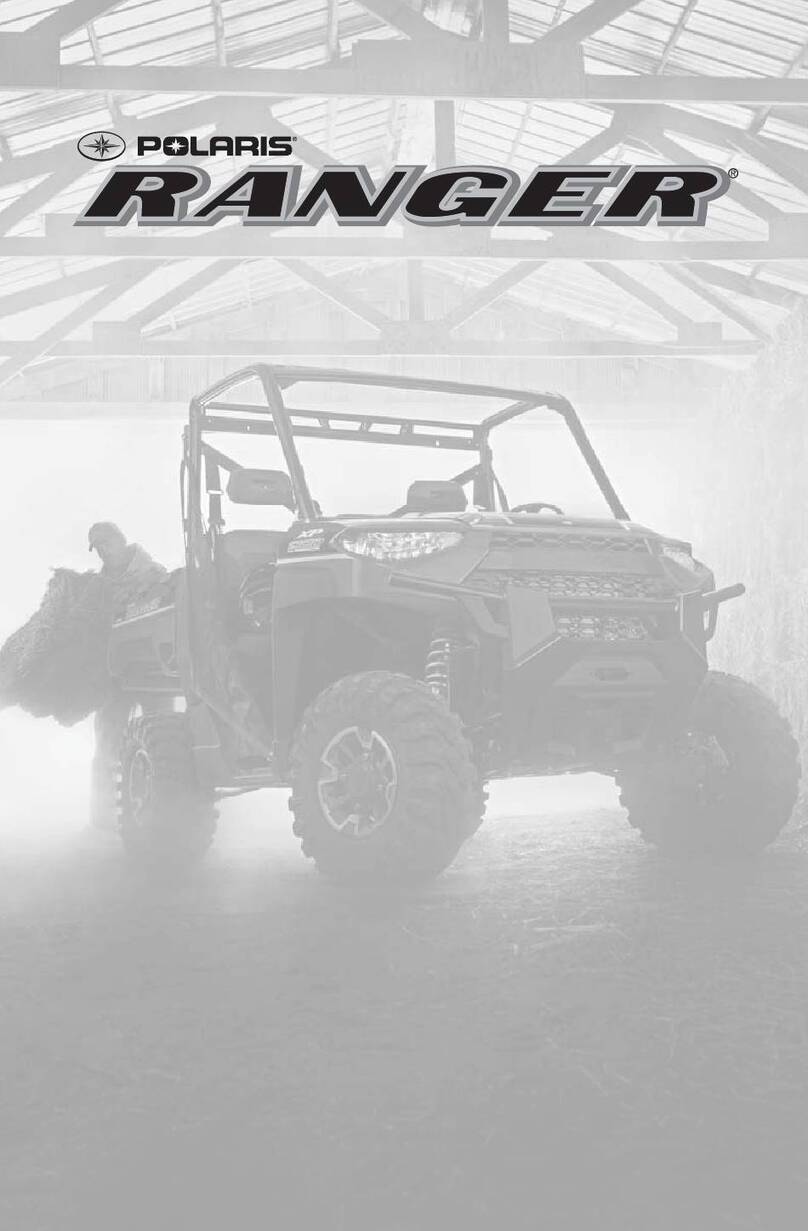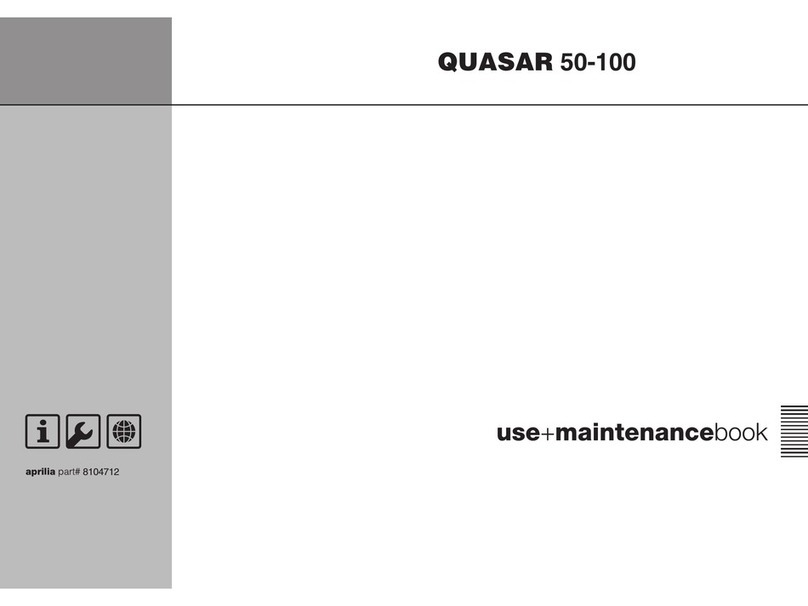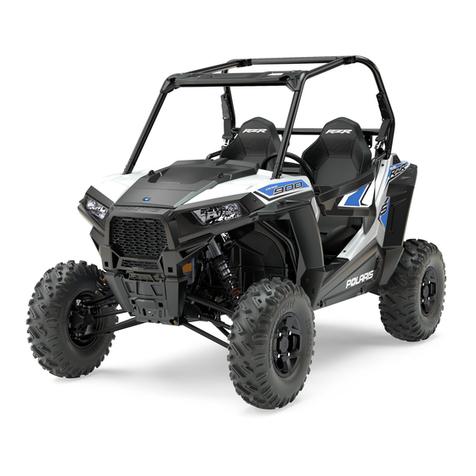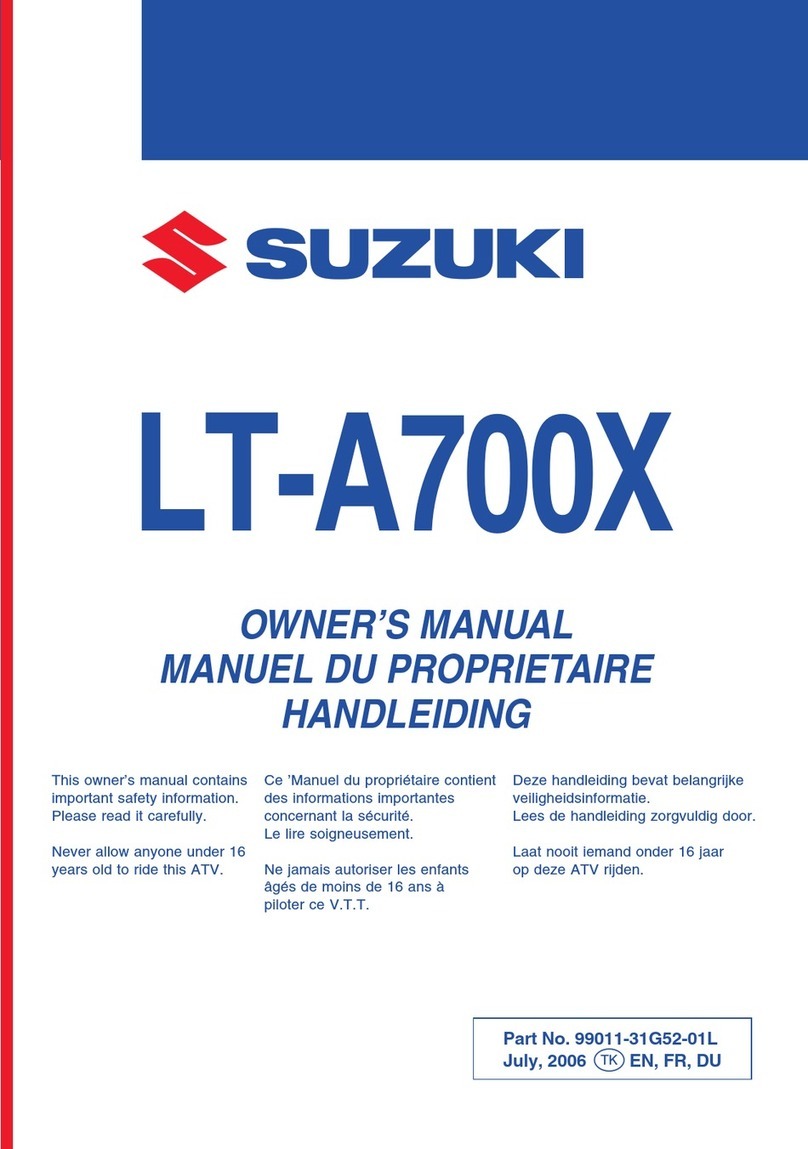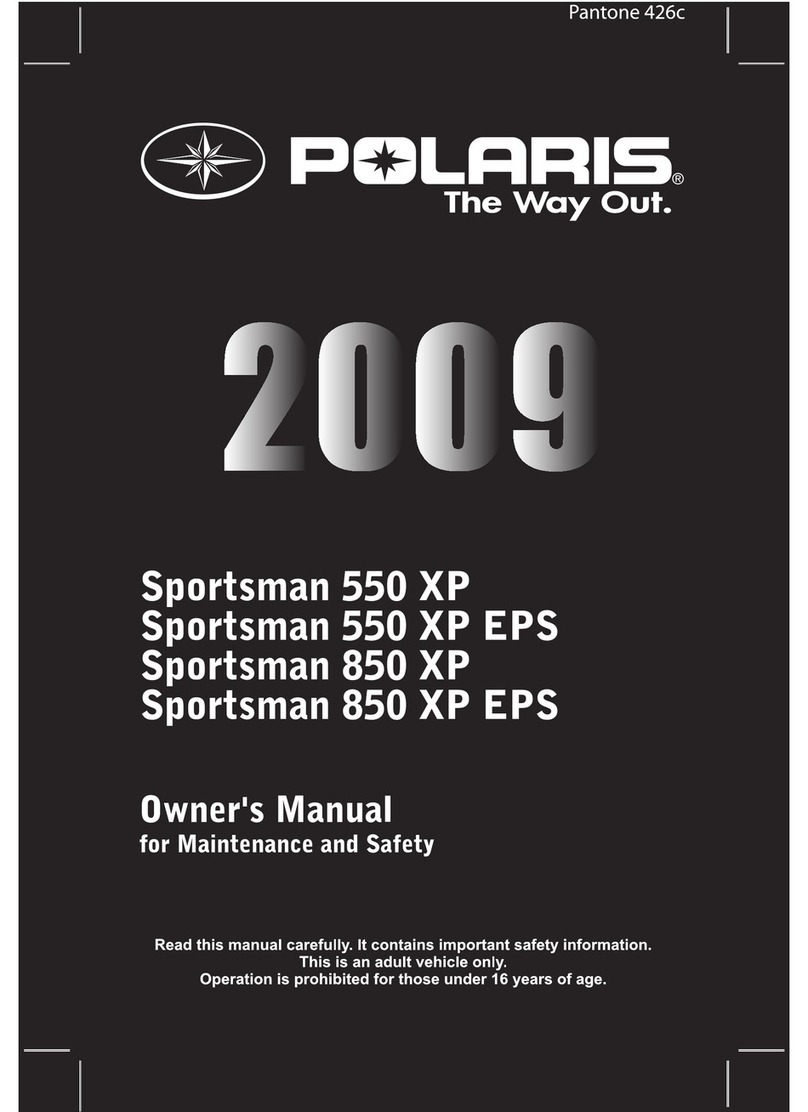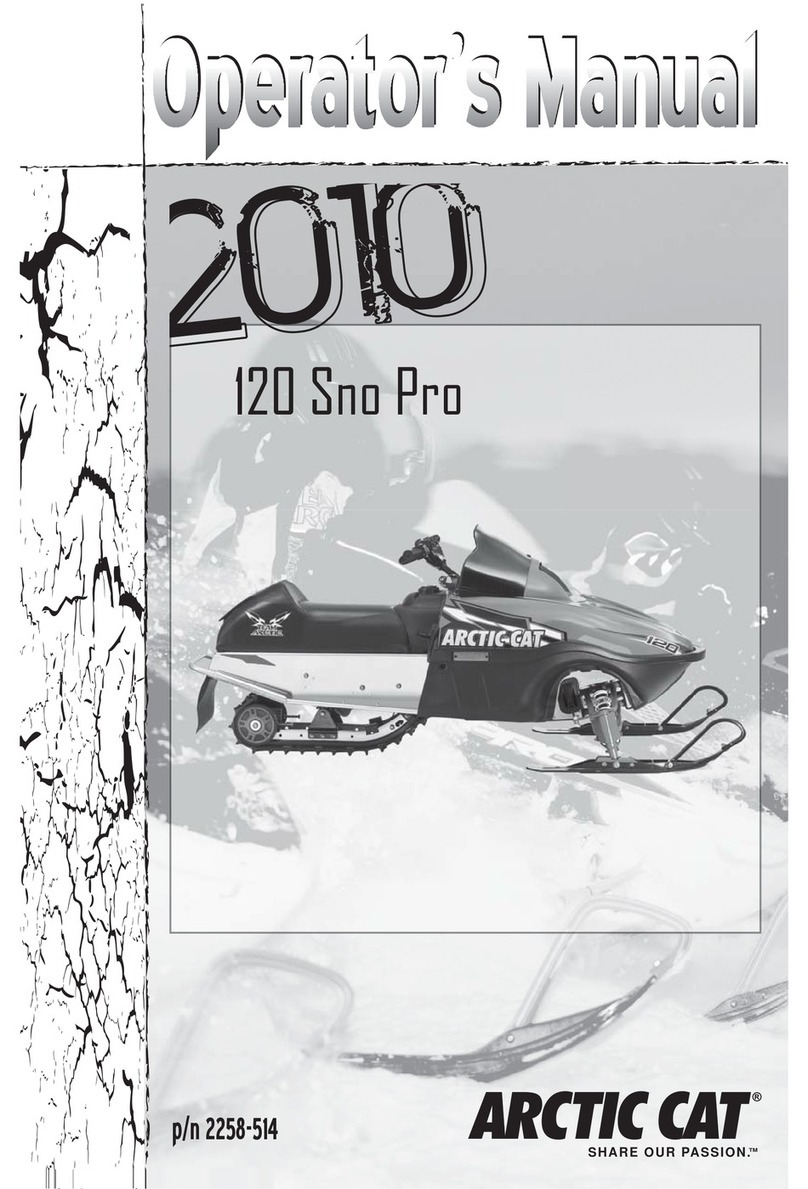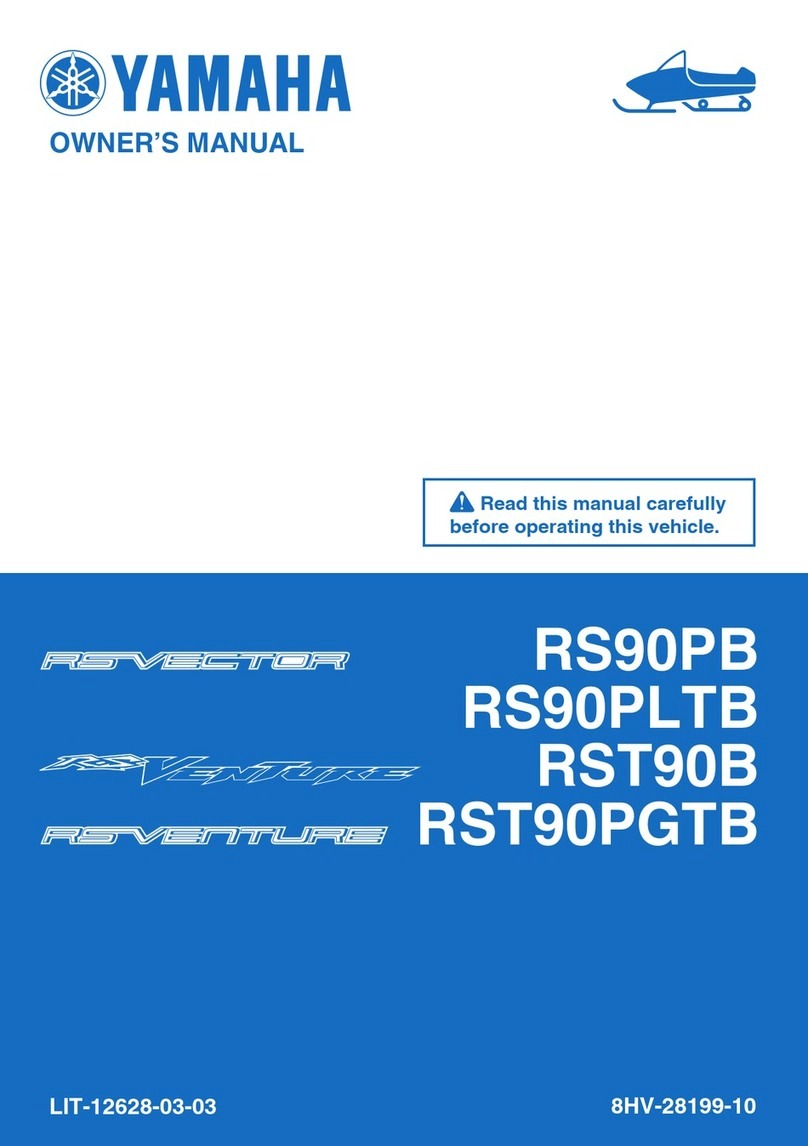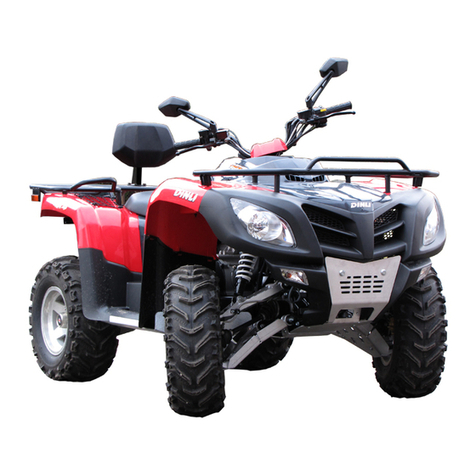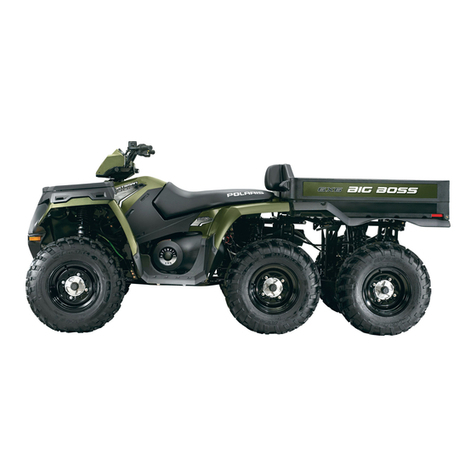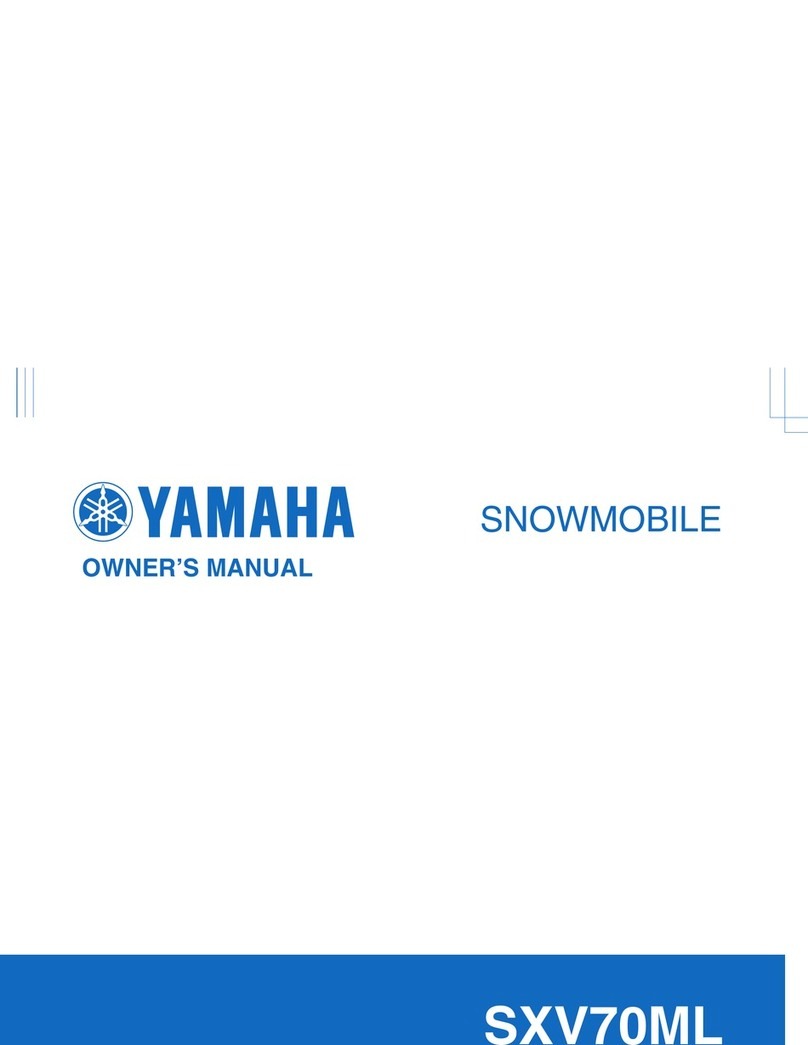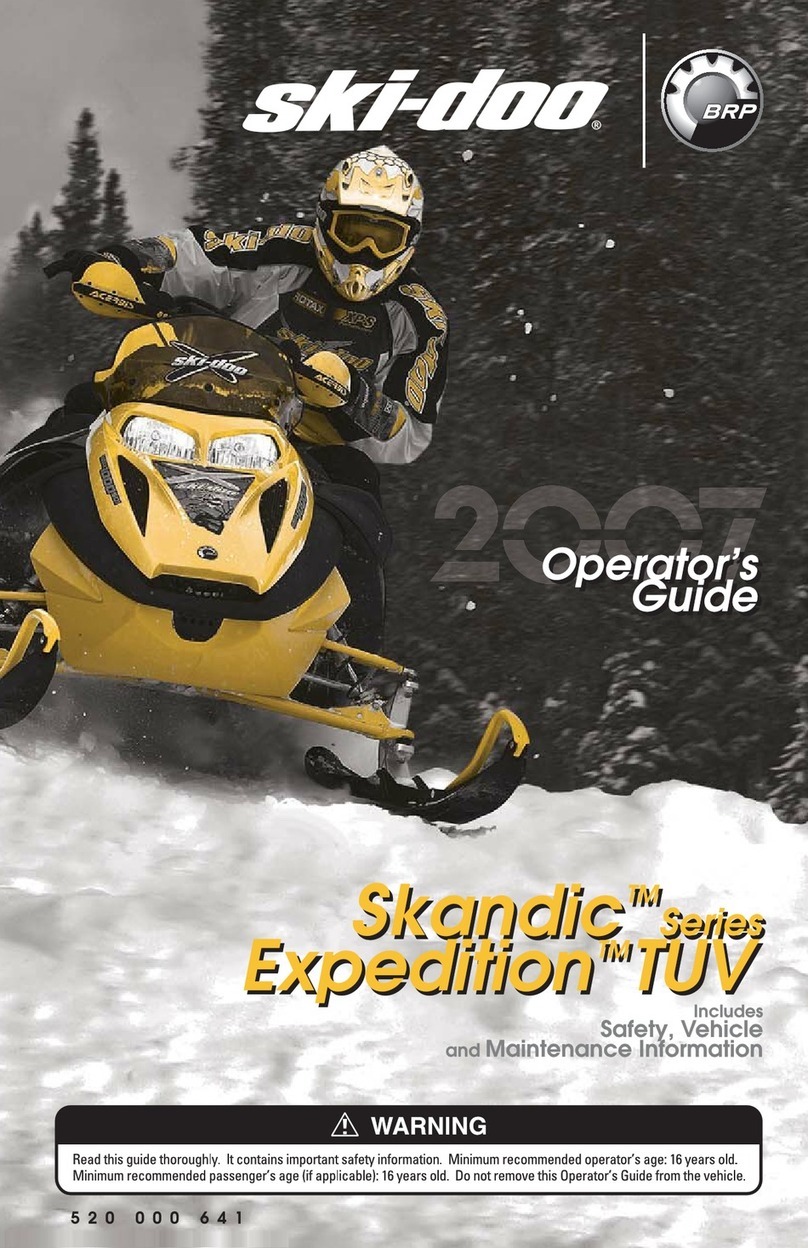Tracker Off-Road 500S User manual

500S
SERVICE MANUAL
p/n: 2262-399
9/20


1
Table of Contents
General Information/Foreword ....................................... 2
Specifications ............................................................... 2
Torque Specifications ................................................... 3
Torque Conversions (ft-lb/N-m).................................... 4
Gasoline — Oil — Lubricant ......................................... 4
Preparation for Storage ................................................ 5
Preparation after Storage ............................................. 6
Periodic Maintenance/Tune-Up ...................................... 7
Air Inlet Pre-Filter.......................................................... 7
Air Filter/Housing Drain................................................. 7
Valve/Tappet Clearance................................................ 8
Testing Engine Compression........................................ 9
Spark Plug .................................................................. 10
Muffler/Spark Arrester................................................. 10
Engine/Transmission Oil — Filter ............................... 10
Front Differential — Rear Drive Lubricant....................11
Driveshaft/Coupling .................................................... 12
Headlight — Taillight/ Brake Light — Reverse Light... 12
Shift Cable .................................................................. 13
Hydraulic Brake System ............................................. 14
Burnishing Brake Pads ............................................... 16
Checking/Replacing V-Belt ......................................... 16
Steering/Body/Controls ................................................ 19
Steering Wheel ........................................................... 19
Steering System ......................................................... 19
Steering Knuckles....................................................... 23
Accelerator Pedal ....................................................... 25
Shift Lever .................................................................. 26
Shift Cable .................................................................. 26
LCD Gauge................................................................. 28
Front Wheel Alignment ............................................... 28
Front Fascia/Front Bumper......................................... 28
Hood/Front Storage Compartment ............................. 30
Front Body Panel........................................................ 30
Floor ........................................................................... 31
Dashboard .................................................................. 33
Belly Panel.................................................................. 35
Muffler......................................................................... 35
Cargo Box................................................................... 36
Tailgate ....................................................................... 36
Taillight Assembly ....................................................... 37
Seat ............................................................................ 38
Troubleshooting .......................................................... 39
Engine/Transmission.................................................... 40
Troubleshooting...........................................................41
Removing Engine/Transmission..................................43
Servicing Engine .........................................................47
Installing Engine/Transmission....................................86
Fuel/Lubrication/Cooling.............................................. 91
Throttle Body...............................................................91
Gas Tank .....................................................................92
Oil Pump .....................................................................94
Liquid Cooling System ................................................95
Troubleshooting...........................................................98
Electrical System .......................................................... 99
Battery.........................................................................99
Ignition Switch ...........................................................100
Ignition Coil ...............................................................100
Ignition Timing ...........................................................101
Accessory Connector ................................................101
Switches....................................................................102
Fan Motor..................................................................104
Power Distribution Module (PDM).............................104
EFI Sensors/Components .........................................105
RPM Limiter .............................................................. 110
Stator Coil ................................................................. 110
Regulator/Rectifier .................................................... 110
Starter Motor ............................................................. 111
Starter Relay ............................................................. 111
Electronic Control Module (ECM).............................. 112
EFI Diagnostic System..............................................112
Troubleshooting......................................................... 117
Drive System ................................................................118
Front Drive Actuator .................................................. 118
Front Differential........................................................120
Drive Axles ................................................................132
Rear Gear Case ........................................................136
Hub............................................................................142
Hydraulic Brake Caliper.............................................144
Troubleshooting Drive System ..................................148
Troubleshooting Brake System .................................148
Suspension.................................................................. 149
Shock Absorbers .......................................................149
Front A-Arms .............................................................149
Rear A-Arms..............................................................152
Wheels and Tires ......................................................154
Troubleshooting.........................................................155

2
General Information/
Foreword
This Service Manual contains service, maintenance, and
troubleshooting information for the 2021 500S model.
The complete manual is designed to aid service personnel
in service-oriented applications.
This manual is divided into sections. Each section covers
a specific vehicle component or system and, in addition
to the standard service procedures, includes disassem-
bling, inspecting, and assembling instructions. When
using this manual as a guide, the technician should use
discretion as to how much disassembly is needed to cor-
rect any given condition.
This service manual is designed primarily for use by a
basic level technician. The procedures found in this man-
ual are of varying difficulty, and certain service proce-
dures in this manual require one or more special tools to
be completed. The technician should use sound judgment
when determining which procedures can be completed
based on their skill level and access to appropriate special
tools.
NOTE: Whenever a part is worn excessively,
cracked, or damaged in any way, replacement is nec-
essary.
When replacement of parts is necessary, use only genuine
parts. They are precision-made to ensure high quality and
correct fit. Refer to the appropriate Illustrated Parts Man-
ual for the correct part number, quantity, and description.
All publications and decals display the words Warning,
Caution, Note, and At This Point to emphasize important
information. The symbol !WARNINGidentifies
personal safety-related information. Be sure to follow the
directive because it deals with the possibility of serious
personal injury or even death. A CAUTION identifies
unsafe practices which may result in vehicle-related dam-
age. Follow the directive because it deals with the possi-
bility of damaging part or parts of the vehicle. The
symbol NOTE: identifies supplementary information
worthy of particular attention. The symbol AT
THIS POINT directs the technician to certain and
specific procedures to promote efficiency and to improve
clarity.
At the time of publication, all information, photographs,
and illustrations were technically correct. Some photo-
graphs used in this manual are used for clarity purposes
only and are not designed to depict actual conditions.
Because we constantly refine and improve our products,
no retroactive obligation is incurred.
All materials and specifications are subject to change
without notice.
Specifications
NOTE: Specifications subject to change without notice.
CHASSIS
Dry Weight (approx) 496.7 kg (1095 lb)
ROPS Tested Curb Weight 997.9 kg (2200 lb)
Length (overall) 270.3 cm (106.4 in.)
Height (overall) 194.8 cm (76.7 in.)
Width (overall) 143.3 cm (56.4 in.)
Tire Size (front)
(rear)
25 x 8-12
25 x 10-12
Tire Inflation Pressure (w/cargo) (front)
(rear)
82.7 kPa (12 psi)
137.9 kPa (20 psi)
MISCELLANEOUS
Spark Plug Type NGK CR6E
Spark Plug Gap 0.7-0.8 mm (0.028-0.031 in.)
Gas Tank Capacity 32.2 L (8.5 U.S. gal.)
Coolant Capacity 2.5 L (2.65 U.S. qt)
Front Differential Capacity (change) 250 ml (8.45 fl oz)*
Rear Drive Capacity (change) 230 ml (7.78 fl oz)*
Engine Oil Capacity (approx) 2.8 L (3.0 U.S. qt) —
Overhaul
2.4 L (2.5 U.S. qt) —
Change
Gasoline (recommended) 87 Octane Regular
Unleaded
Engine Oil (recommended) ACX All Weather Synthetic
Front Differential/Rear Drive Lubricant
(At level plug hole)
SAE Approved 80W-90
Hypoid
Drive Belt Width 28.5 mm (1.12 in.)
Brake Fluid DOT 4
Taillight/Brake Light/Reverse light 12V/5W/21W
Headlight (high beam/low beam) 12V/60W/55W
ELECTRICAL SYSTEM
Ignition Timing 12° BTDC @ 1425 RPM
Spark Plug Cap 4000-6000 ohms
Ignition Coil Resistance (primary)
(secondary)
Less than 1 ohm
N/A
Ignition Coil Primary Voltage Battery Voltage
Stator Coil Resistance (CKP Sensor)
(AC generator)
104-156 ohms
Less than 1 ohm
AC Generator Output (no load) 75 AC volts @ 5000 RPM
Crankshaft Position Sensor AC Voltage 2.0 volts or more
VALVES AND GUIDES
Valve Face Diameter (intake)
(exhaust)
30.6 mm
27.0 mm
Valve/Tappet Clearance (intake)
(cold engine) (exhaust)
0.10 mm
0.17 mm
Valve Guide/Stem (intake)
Clearance (max) (exhaust)
0.04 mm
0.06 mm
Valve Guide Inside Diameter 5.000-5.012 mm
Valve Seat Angle (intake/exhaust) 45°
Valve Spring Free Length (min) 42.8 mm
Valve Spring Tension @ 35.2 mm 18.6 kg (41.1 lb)

3
Torque Specifications
NOTE: Torque specifications have the following tol-
erances:
CYLINDER, PISTON, AND RINGS
Piston Skirt/Cylinder Clearance 0.60-0.73 mm
Piston Diameter 15 mm from Skirt End 88.96-88.98 mm
Piston Ring Free End Gap (max) (1st)
(2nd)
8.0 mm
8.3 mm
Bore x Stroke 89.0 x 71.2 mm
Cylinder Trueness (max) 0.01 mm
Piston Ring End Gap — Installed (min) 0.30 mm
Piston Ring to Groove Clearance (max)
(1st/2nd)
0.06 mm
Piston Ring Groove Width (1st)
(2nd)
(oil)
1.01-1.03 mm
1.21-1.23 mm
2.01-2.03 mm
Piston Ring Thickness (1st)
(2nd)
1.01-1.03 mm
1.17-1.19 mm
Piston Pin Bore (max) 20.008 mm
Piston Pin (min) 19.994 mm
CRANKSHAFT
Connecting Rod (small end) (max) 20.021 mm
Connecting Rod (big end side-to-side) 0.10-0.55 mm
Connecting Rod (big end width) 21.95-22.00 mm
Connecting Rod (small end deflection)
(max)
3.0 mm
Crankshaft (web-to-web) 60.9 mm
Crankshaft Runout (max) 0.03 mm
CAMSHAFT AND CYLINDER HEAD
Cam Lobe Height (min)(intake)
(exhaust)
34.71 mm
34.48 mm
Camshaft Journal Holder (right & center)
Inside Diameter (left)
22.01-22.04 mm
17.51-17.54 mm
Camshaft Journal Outside(right & center)
Diameter (left)
17.466-17.480 mm
21.959- 21.980 mm
Camshaft Runout (max) 0.03 mm
Cylinder Head/Cover Distortion (max) 0.05 mm
Torque (ft-lb) Tolerance
0-15 ±20%
16-39 ±15%
40+ ±10%
Part Part Bolted to Torque
ft-lb N-m
EXHAUST COMPONENTS
Exhaust Pipe Cylinder Head 15 20.4
Spark Arrester Muffler 50 in.-lb 5
O2 Sensor Exhaust Pipe 18.5 25
BRAKE COMPONENTS
Brake Disc (Front/Rear)** Hub 25 34
Brake Hose Caliper 25 34
Brake Hose Master Cylinder 25 34
Master Cylinder Frame 15.5 21
Caliper**** Knuckle 20 27.2
Brake Pedal Frame 15.6 21.1
Rear Caliper Bracket Gear Case 32 45
Banjo Bolt Brakeline Junction 18 25
ELECTRICAL COMPONENTS
Coil* Bracket 8 11
STEERING COMPONENTS
Steering Wheel** Steering Shaft 25 34
Rack and Pinion Assembly Frame 35 48
Tie Rod End** Knuckle 30 41
Tie Rod Tie Rod End 8 11
Intermediate Shaft Steering Column 15 20.4
Intermediate Shaft Rack 15 20.4
Tilt Assembly Steering Support 23 31.3
Gas Spring Steering Support 15 20.4
CHASSIS/ROPS ASSEMBLY
Shift Axle Support Frame 48 in.-lb 5
Front/Rear ROPS Tube Arm Rest/Steering Support 47 64
Top ROPS Support Front/Rear ROPS Tubes 47 64
Rear ROPS Tube Lower ROPS Support 47 64
Shift Lever/Lever Assembly Frame 15 20.4
Shift Cable Mounting/Adjuster Shift Cable 20 27
Seat Belt Loop ROPS 42 57
Side Panel/Spacer Cargo Box Frame 25 34
Tilt Pivot Bushing Cargo Box Frame 15 20.4
Latch Striker Cargo Box Liner 60 in.-lb 7

4
* w/Blue Loctite #243 ** w/Red Loctite #271
*** w/Green Loctite #270 **** w/“Patch-Lock”
Torque Conversions
(ft-lb/N-m)
Gasoline — Oil — Lubricant
FILLING GAS TANK
Since gasoline expands as its temperature rises, the gas tank
must be filled to its specified capacity only. Expansion room
must be maintained in the tank particularly if the tank is filled
with cold gasoline and then moved to a warm area.
Tighten the gas tank cap securely after filling the tank.
RECOMMENDED GASOLINE
The recommended gasoline to use is 87 minimum octane
regular unleaded. In many areas, oxygenates are added to
the gasoline. Oxygenated gasolines containing up to 10%
ethanol or 5% methanol are acceptable gasolines.
Part Part Bolted to Torque
ft-lb N-m
SUSPENSION COMPONENTS (Front)
A-Arm Frame 35 48
Knuckle Ball Joint 35 48
Shock Absorber Frame/Upper A-Arm 32.5 44
SUSPENSION COMPONENTS (Rear)
A-Arm Frame 35 48
Shock Absorber Lower A-Arm/Frame 32 43.5
Knuckle A-Arm 35 48
DRIVETRAIN COMPONENTS
Gear Case Frame 39 53
Front Differential Frame 39 53
Differential Gear Stay Frame 23 31.3
Pinion Housing Differential Housing 16.5 22
Driveshaft Flange (Front/Rear) Engine Flange 20 27.2
Front/Rear Drive Flange Secondary Output Shaft 59 80
Differential Housing Cover*** Differential Housing 16.5 22
Drive Bevel Gear Nut*** Shaft 72 98
Driven Bevel Gear Shaft 101 137
Hub Nut Front/Rear Shaft/Axle
(min)
200 271
Oil Drain Plug/Check Plug Rear Gear Case 15 20.4
Filler Cap Rear Gear Case 11 15
Drain Plug Front Differential 23 in.-lb 2.6
Check Plug Front Differential 7.2 9.8
Oil Fill Plug Front Differential 25 34
Engine Oil Drain Plug Engine 18 24.5
Wheel (Steel) Hub 45 61
Wheel (Aluminum w/black nuts) Hub 60 81
Wheel (Aluminum w/chrome
nuts)
Hub 80 108
ENGINE/TRANSMISSION
Engine Cradle Frame 25 34
Engine Cradle Engine 43 58
Cam Sprocket** Camshaft 10 14
Valve Cover Cylinder Head 8.5 11.5
Tappet Cover Valve Cover 8.5 11.5
Cylinder Head (Cap Screw) Crankcase 28 38
Cylinder/Cylinder Head (Nut) Cylinder 8 11
Clutch Shoe** Crankshaft 147 199
Driven Pulley** Driveshaft 85 115
Ground Wire Engine 8 11
Magneto Cover Crankcase 10 14
Speed Sensor Housing Crankcase 8 11
CVT Cover Clutch Cover/Housing 8 11
Movable Drive Face Centrifugal Clutch Housing 85 115
Starter Clutch** Flywheel 16 22
Rotor Crankshaft 107 145
Stator Coil
**
Magneto Cover (New) 13 18
Stator Coil
Magneto Cover (Existing)
11.5 15
Oil Strainer Crankcase 54 in.-lb 6
Oil Pump** Crankcase 8.5 11.5
Water Pump/Housing Magneto Cover 8 11
Crankcase Half (6 mm) Crankcase Half 10 14
Crankcase Half (8 mm) Crankcase Half 21 28
Starter Motor Crankcase 10 14
Shift Cam Plate Shift Cam Shaft 8 11
Oil Pump Drive Gear** Crankshaft 63 85
Cam Chain Tensioner Guide Cylinder Head 11 15
Cam Chain Tensioner Cylinder 10 14
Water Pump Drive Gear Crankshaft 28 38
Water Pump Cover Water Pump Housing 8 11
ft-lb N-m ft-lb N-m ft-lb N-m ft-lb N-m
11.4 26 35.4 51 69.4 76 103.4
22.7 27 36.7 52 70.7 77 104.7
34.1 28 38.1 53 72.1 78 106.1
45.4 29 39.4 54 73.4 79 107.4
56.8 30 40.8 55 74.8 80 108.8
68.2 31 42.2 56 76.2 81 110.2
79.5 32 43.5 57 77.5 82 111.5
810.9 33 44.9 58 78.9 83 112.9
912.2 34 46.2 59 80.2 84 114.2
10 13.6 35 47.6 60 81.6 85 115.6
11 15 36 49 61 83 86 117
12 16.3 37 50.3 62 84.3 87 118.3
13 17.7 38 51.7 63 85.7 88 119.7
14 19 39 53 64 87 89 121
15 20.4 40 54.4 65 88.4 90 122.4
16 21.8 41 55.8 66 89.8 91 123.8
17 23.1 42 57.1 67 91.1 92 125.1
18 24.5 43 58.5 68 92.5 93 126.5
19 25.8 44 59.8 69 93.8 94 127.8
20 27.2 45 61.2 70 95.2 95 129.2
21 28.6 46 62.6 71 96.6 96 130.6
22 29.9 47 63.9 72 97.9 97 131.9
23 31.3 48 65.3 73 99.3 98 133.3
24 32.6 49 66.6 74 100.6 99 134.6
25 34 50 68 75 102 100 136
! WARNING
Always fill the gas tank in a well-ventilated area. Never add
fuel to the gas tank near any open flames or with the engine
running. DO NOT SMOKE while filling the gas tank.
! WARNING
Do not overflow gasoline when filling the gas tank. A
fire hazard could materialize. Always allow the engine to
cool before filling the gas tank.
! WARNING
Do not over-fill the gas tank.

5
When using ethanol-blended gasoline, it is not necessary
to add a gasoline antifreeze since ethanol will prevent the
accumulation of moisture in the fuel system.
RECOMMENDED ENGINE/
TRANSMISSION OIL
The recommended oil to use is ACX All Weather syn-
thetic engine oil, which has been specifically formulated
for use in this engine. Although ACX All Weather syn-
thetic engine oil is the only oil recommended for use in
this engine, use of any API-certified SM 0W-40 oil is
acceptable.
OILCHARTJ
RECOMMENDED FRONT
DIFFERENTIAL/REAR DRIVE
LUBRICANT
The recommended lubricant is SAE-approved 80W-90
hypoid. This lubricant meets all of the lubrication
requirements of the front differential and rear drive.
Preparation for Storage
The manufacturer recommends the following procedure to
prepare the vehicle for storage. An authorized dealer should
perform this service; however, the owner/operator may per-
form this service if desired.
1. Clean the vehicle thoroughly by washing dirt, oil, grass,
and other foreign matter from the entire vehicle. Allow
the vehicle to dry thoroughly. DO NOT get water into
any part of the engine or air intake.
2. Either drain the gas tank or add a fuel stabilizer to the
gas in the gas tank.
3. Clean the interior of the air filter housing.
4. Plug the hole in the exhaust system with steel wool.
5. Apply light oil to the upper steering shaft via the access
hole. Remove the rubber plug located on the left side of
the steering column cover and plungers of the shock
absorbers.
PK094A
6. Tighten all nuts, bolts, cap screws, and screws. Make
sure rivets holding components together are tight.
Replace all loose rivets. Care must be taken that all cal-
ibrated nuts, cap screws, and bolts are tightened to
specifications.
7. Fill the cooling system to the bottom of the stand pipe
in the radiator neck with properly mixed coolant. Check
the coolant level in the reservoir tank; it should be in
between the MIN and MAX markings.
8. Disconnect the battery cables (negative cable first);
then remove the battery, clean the battery posts and
cables, and store in a clean, dry area.
NOTE: For storage, use a battery maintainer or make
sure the battery is fully charged (see Battery section in
this manual).
9. Store the vehicle indoors in a level position.
CAUTION
Do not use white gas. Only approved gasoline additives
should be used.
CAUTION
Any oil used in place of the recommended oil could
cause serious engine damage. Do not use oils which
contain graphite or molybdenum additives. These oils
can adversely affect clutch operation. Also, not recom-
mended are racing, vegetable, non-detergent, and cas-
tor-based oils.
CAUTION
Any lubricant used in place of the recommended lubri-
cant could cause serious front differential/rear drive
damage.
CAUTION
Prior to storing this vehicle, it must be properly ser-
viced to prevent rusting and component deterioration.
CAUTION
Avoid storing outside in direct sunlight and avoid using a
plastic cover as moisture will collect on the vehicle caus-
ing rusting.

6
Preparation after Storage
Taking this vehicle out of storage and correctly preparing
it will ensure many hours of trouble-free riding. The
manufacturer recommends the following procedure:
1. Clean the vehicle thoroughly.
2. Remove the steel wool from the exhaust system.
3. Check all control wires and cables for signs of wear
or fraying. Replace if necessary.
4. Change the engine/transmission oil and filter.
5. Check the coolant level and add properly mixed
coolant as necessary.
6. Charge the battery; then install. Connect the battery
cables making sure to connect the positive cable
first.
7. Check the entire brake systems (fluid level, pads,
etc.), all controls, headlights, taillight, brake light,
and headlight aim; adjust or replace if necessary.
8. Check the tire pressure. Inflate to recommended
pressure as necessary.
9. Tighten all nuts, bolts, cap screws, and screws mak-
ing sure all calibrated nuts, cap screws, and bolts are
tightened to specifications.
10. Make sure the steering moves freely and does not
bind.
11. Check the spark plug. Clean or replace as necessary.
12. Check the air filter and the air filter housing. Clean
or replace as necessary.
CAUTION
Before installing the battery, make sure the ignition
switch is in the OFF position.

7
Periodic Maintenance/
Tune-Up
Tighten all nuts, bolts, and cap screws. Care must be
taken that all calibrated nuts, bolts, and cap screws are
tightened to specifications.
It is advisable to lubricate certain components periodi-
cally to ensure free movement. Apply light oil to the
components using the following list as reference:
A. Accelerator Pedal Pivot/Cable Ends
B. Brake Pedal Pivot
C. Shift Cable
SPECIAL TOOLS
A number of special tools must be available to the techni-
cian when performing service procedures in this section.
Refer to the current Special Tools Catalog for the appro-
priate tool description.
NOTE: When indicated for use, each special tool
will be identified by its specific name, as shown in the
chart below, and capitalized.
NOTE: Special tools are available from the Service
Department.
Air Inlet Pre-Filter
This vehicle is equipped with a pre-filter to filter dirt
from the inlet air prior to reaching the main air filter.
NOTE: The pre-filter is located above the front
right wheel well under the front body panel.
1. To remove the pre-filter, remove the two machine
screws; then remove the filter frame and filter from
behind the inlet tube.
PK095
PK096A
2. Wash the pre-filter thoroughly in warm, soapy water;
then rinse and dry.
3. Install the pre-filter and frame; then secure with the
two machine screws. Tighten securely.
Air Filter/Housing Drain
The air filter inside the air filter housing must be kept
clean to provide good engine power and gas mileage. If
the vehicle is used under normal conditions, service the
filter at the intervals specified. If operated in dusty, wet,
or muddy conditions, inspect and service the filter more
frequently. Use the following procedure to remove the
filter and inspect and/or clean it.
NOTE: To access the air filter, the seat must be
removed.
1. Remove dirt and debris from around the filter hous-
ing.
2. Unsnap the seven spring-clips and remove the air fil-
ter cover; then loosen the clamp securing the air fil-
ter.
PK008A
3. Remove the Phillips screw to separate the air filter
holders from the air filter.
Description p/n
Compression Tester Kit Common Tool
Oil Filter Wrench Common Tool
Timing Light Common Tool
Valve Clearance Adjuster 0444-255 CAUTION
Failure to inspect the air filter frequently if the vehicle is
used in dusty, wet, or muddy conditions can damage the
engine.

8
PK321
4. Slide out the air filter screen, then separate the inner
and outer air filter elements to thoroughly clean.
PK322
5. Place the element in a pan larger than the element
and spray all sides generously with cleaning solvent,
let sit approximately 3 minutes.
6. In a pan larger than the element, with a mild deter-
gent (dish soap) and water, wash all the dirt and oil
off by squeezing the element, not twisting it. (Ring-
ing out or twisting the filter can cause damage.)
NOTE: Cleaning Solvent and Spray-On Foam Air
Filter Oil are available from the manufacturer.
7. Rinse off any remaining soap.
8. Remove any excess water from the element by mat-
ting with a towel.
9. Allow the element to dry completely.
10. Place the outer element over the inner air filter ele-
ment.
11. Spray oil generously onto air filter and work the oil
into the element.
12. Squeeze the element to remove excess oil.
13. Clean any dirt or debris from inside the filter hous-
ing.
14. Inspect the drain cap beneath the main housing for
debris and for proper sealing. From under the vehicle
check the drain located on the bottom of the intake
tube.
PK097
PK009
15. Insert the air filter screen into the inner element then
secure the air filter holders with the Phillips screw.
16. Install the air filter and secure with the clamp.
17. Install the air filter cover and secure with the spring-
clips. Install the seat and make sure it is securely
latched.
Valve/Tappet Clearance
NOTE: The engine must be cold for this procedure.
NOTE: The seat and spark plug must be removed
for this procedure. To aid in adjustment, it is recom-
mended the cargo box also be removed (see Cargo
Box section).
1. Remove the spark plug, timing inspection plug, and
magneto cover plug; then remove the tappet covers
(for more detailed information, see Engine/Trans-
mission — Servicing Top-Side Components).
CAUTION
A torn air filter can cause damage to the engine. Dirt and
dust may get inside the engine if the element is torn. Care-
fully examine the element for tears before and after cleaning
it. Replace the element with a new one if it is torn.

9
FI605A
FI603
2. Rotate the crankshaft to the TDC position on the
compression stroke by aligning the rotor mark to the
crankcase marking.
FI709
NOTE: At this point, the rocker arms and adjuster
screws must not have pressure on them.
CHECKING
Using a feeler gauge, check each valve/tappet clearance. If
clearance is not within specifications, loosen the jam nut
and rotate the tappet adjuster screw until the clearance is
within specifications. Tighten each jam nut to 7 ft-lb (9.5
N-m) after completing the adjustment.
ADJUSTING
A. Place the Valve Clearance Adjuster onto the jam nut
securing the tappet adjuster screw; then rotate the
valve adjuster dial clockwise until the end is seated
in the tappet adjuster screw.
B. While holding the valve adjuster dial in place, use
the valve adjuster handle and loosen the jam nut;
then rotate the tappet adjuster screw clockwise until
friction is felt.
C. Align the valve adjuster handle with one of the
marks on the valve adjuster dial.
D. While holding the valve adjuster handle in place,
rotate the valve adjuster dial counterclockwise until
proper valve/tappet clearance is attained.
NOTE: Refer to the specifications in CHECKING
for the proper valve/tappet clearance.
NOTE: Rotating the valve adjuster dial counter-
clockwise will open the valve/tappet clearance by 0.05
mm (0.002 in.) per mark.
E. While holding the adjuster dial at the proper clear-
ance setting, tighten the jam nut securely with the
valve adjuster handle.
3. Install the spark plug; then install the timing inspec-
tion plug and magneto cover plug.
4. Place the two tappet covers with O-rings into posi-
tion. Tighten the cap screws to 8 ft-lb (10.9 N-m).
Testing Engine
Compression
NOTE: The engine should be warm (operating tem-
perature) and the battery fully charged for an accu-
rate compression test. The throttle must be in the
wide-open throttle (WOT) position. In the event the
engine cannot run up to operating temperature, cold
values are included.
NOTE: The seat must be removed for this proce-
dure.
1. Remove the high tension lead from the spark plug.
2. Using compressed air, blow any debris from around
the spark plug.
3. Remove the spark plug; then attach the high tension
lead to the plug and ground the plug on the cylinder
head well away from the spark plug hole.
4. Attach the Compression Tester Kit.
CAUTION
The feeler gauge must be positioned at the same angle
as the valve and valve adjuster for an accurate mea-
surement of clearance. Failure to measure the valve
clearance accurately could cause valve component
damage.
VALVE/TAPPET CLEARANCE
Intake 0.1016 mm (0.004 in.)
Exhaust 0.1778 mm (0.007 in.)
! WARNING
Always wear safety glasses when using compressed
air.

10
5. While holding the throttle in the full-open position,
crank the engine over with the electric starter until
the gauge stops climbing (five to 10 compression
strokes).
6. If compression is abnormally low, inspect the
following items:
A. Starter cranks engine over.
B. Gauge is functioning properly.
C. Throttle in the full-open position.
D. Valve/tappet clearance correct.
E. Engine warmed up.
F. Intake obstructed.
NOTE: To service top-side components, see Engine/
Transmission.
7. Pour approximately 30 ml (1 fl oz) of oil into the
spark plug hole, reattach the gauge, and retest com-
pression.
8. If compression is now evident, service the top end
(see the appropriate Engine/Transmission — Top-
Side Components).
Spark Plug
A light brown insulator indicates that the plug and fuel/
air ratio are correct. A white or dark insulator indicates
that the engine may need to be serviced. To maintain a
hot, strong spark, keep the plug free of carbon.
ATV-0051
Adjust the gap to 0.7-0.8 mm (0.028-0.031 in.).
ATV0052
A new spark plug should be tightened 1/2 turn once the
washer contacts the cylinder head. A used spark plug
should be tightened 1/8-1/4 turn once the washer contacts
the cylinder head.
Muffler/Spark Arrester
The muffler has a spark arrester which must be periodi-
cally cleaned. At the intervals shown in the Maintenance
Schedule, clean the spark arrester using the following
procedure:
1. Remove the cap screws securing the spark arrester
assembly to the muffler.
PK010
2. Using a suitable brush, clean the carbon deposits
from the screen taking care not to damage the screen.
NOTE: If the screen or gasket is damaged in any
way, it must be replaced.
3. Install the spark arrester assembly and secure with
the cap screws. Tighten to 50 in.-lb (5.6 N-m).
Engine/Transmission Oil —
Filter
OIL — FILTER
Change the engine oil and oil filter at the scheduled inter-
vals. The engine should always be warm when the oil is
changed so the oil will drain easily and completely.
PSI Hot (WOT) PSI Cold (WOT)
125-145 100-140
CAUTION
Before removing the spark plug, be sure to clean the
area around the spark plug. Dirt could enter engine
when removing or installing the spark plug.
! WARNING
Wait until the muffler cools to avoid burns.

11
1. Park the vehicle on level ground.
2. Remove the drain plug from the bottom of the engine
and drain the oil into a drain pan; then remove the
seat. Account for and discard the drain plug gasket.
PR078A
3. Using the Oil Filter Wrench and a ratchet handle (or a
socket or box-end wrench), remove the oil filter; then
verify the oil filter seal has also been removed.
NOTE: Clean up any excess oil after removing the
filter.
4. Apply fresh oil to the new filter O-ring and check to
make sure it is positioned correctly; then install the
new oil filter. Tighten securely.
5. Install the engine drain plug with a new gasket and
tighten to 18 ft-lb (24.5 N-m). Pour the specified
amount of the recommended oil in the filler hole
(located on the right side of the engine).
PK024A
6. Start the engine (while the vehicle is outside on level
ground) and allow it to idle for a few minutes.
7. Turn the engine off and wait approximately 1 min-
ute; then unscrew the oil level stick and wipe it with
a clean cloth.
8. Install the oil level stick and thread into the engine
case.
9. Remove the oil level stick; the oil level must be
within the operating range but not exceeding the
upper mark.
GZ461A
10. Inspect the area around the drain plug and oil filter
for leaks.
Front Differential — Rear
Drive Lubricant
To check lubricant, use the following procedure:
1. Remove each level plug; the lubricant should be
level with the bottom threads.
PK027A
PK028A
2. If low, remove the fill plug and add the appropriate
lubricant until it appears at the bottom of the level
plug threads.
CAUTION
Any oil used in place of the recommended oil could cause
serious engine damage. Do not use oils which contain
graphite or molybdenum additives. These oils can
adversely affect clutch operation. Also, not recommended
are racing, vegetable, non-detergent, and castor-based oils.
CAUTION
Do not over-fill the engine with oil. Always make sure
that the oil level is not above the upper mark.
Front
Rear

12
To change the lubricant, use the following procedure:
1. Place the vehicle on level ground.
2. Remove each fill plug; then inspect the seal (replace
if necessary).
3. Drain the lubricant into a drain pan by removing in
turn the drain plug from each; then inspect the seal
(replace if necessary).
PK029A
4. After all the lubricant has been drained, install the
drain plugs and tighten the front to 23 in.-lb (2.6 N-m)
and rear to 15 ft-lb (20.4 N-m).
5. Pour the appropriate amount of recommended lubri-
cant into the fill hole.
6. Install the fill plugs and tighten the front to 25 ft-lb
(34 N-m) and the rear to 11 ft-lb (15 N-m).
NOTE: If the lubricant is contaminated with water,
inspect the drain plug, fill plug, and/or bladder.
Driveshaft/Coupling
The following drive system components should be
inspected periodically to ensure proper operation:
1. Spline lateral movement (slop).
2. Coupling cracked, damaged, or worn.
Headlight — Taillight/
Brake Light — Reverse Light
NOTE: The bulb portion is fragile. HANDLE
WITH CARE. When replacing the bulb, do not touch
the glass portion. If the glass is touched, it must be
cleaned with a dry cloth before installing. Skin oil res-
idue on the bulb will shorten the life of the bulb.
HEADLIGHT
To replace the headlight bulb, use the following proce-
dure:
1. Rotate the back of the headlight bulb counterclock-
wise; then disconnect the wiring harness and discard
the bulb.
PK062A
2. Connect the new headlight bulb to the wiring harness
and insert into headlight assembly. Turn clockwise to
secure the bulb.
3. Adjust the headlight (see CHECKING/ADJUSTING
HEADLIGHT AIM in this sub-section).
TAILLIGHT/BRAKE LIGHT — REVERSE
LIGHT
To replace the taillight/brake light or reverse light bulb,
use the following procedure:
1. Disconnect the taillight/brake light connector.
2. Remove the two nuts and cap screws securing the
steel tie-down to the cargo box.
PK063B
3. Remove the six plastic screws securing the rear
fender to the cargo box. Remove the rear fender.
! WARNING
Do not attempt to remove the bulb when it is hot. Severe
burns may result.
Front
CAUTION
When replacing the headlight bulb, be careful not to
touch the glass portion of the bulb. Grasp the new bulb
with a clean cloth.

13
PK064A
4. Remove the taillight/brake light socket by rotating
the socket counterclockwise. Rotate the bulb coun-
terclockwise to remove from socket.
PK328
5. To install the taillight/brake light, insert the bulb into
the socket and turn clockwise. Insert the socket into
the taillight assembly and turn clockwise.
6. Place the rear fender onto the cargo box and secure
with the six plastic screws. Secure the tie-down with
the two nuts and cap screws.
7. Connect the taillight/brake light connector.
CHECKING/ADJUSTING HEADLIGHT
AIM
The headlights can be adjusted vertically. The geometric
center of the HIGH beam light zone is to be used for aim-
ing.
1. Position the vehicle on a level floor so the headlights
are approximately 6.1 m (20 ft) from an aiming sur-
face (wall or similar aiming surface).
0748-733
NOTE: There should be an average operating load
on the vehicle when adjusting the headlight aim.
2. Measure the distance from the floor to the midpoint
of each headlight.
3. Using the measurements obtained in step 2, make
horizontal marks on the aiming surface.
4. Make vertical marks which intersect the horizontal
marks on the aiming surface directly in front of the
headlights.
5. Switch on the lights. Make sure the HIGH beam is
on. DO NOT USE LOW BEAM.
6. Observe each headlight beam aim. Proper aim is
when the most intense beam is centered on the verti-
cal mark 5 cm (2 in.) below the horizontal mark on
the aiming surface.
7. Loosen the headlight adjustment screw; then adjust
the headlight up or down as required. Tighten the
headlight adjustment screw.
PK081A
Shift Cable
CHECKING SHIFT CABLE
Turn the ignition switch on; then shift the transmission
into park. The letter P should illuminate on the LCD
gauge and the park icon (P) should illuminate. The vehi-
cle should not be able to move.
PR098
Move the shift lever all the way forward. The letter L
should illuminate on the LCD gauge.

14
PK099
If either park or low range cannot be reached, the shift
cable must be adjusted.
ADJUSTING SHIFT CABLE
1. Place the transmission in park; then remove the seat.
2. Make sure the shift lever is in park; then remove the
E-clip (A) securing the cable end to the shift arm
stud. Account for the washer (B) and bushing (C).
PK100A
3. Loosen nuts (A) and (B) found under the front body
panel and adjust the cable housing to align the shift
cable end to the shift arm stud.
PK101A
4. If proper cable adjustment cannot be achieved after
performing step 3, utilize the second cable adjust-
ment found under the seat.
PK102
5. Place the bushing and cable end onto the shift arm
stud; then install the washer and a new E-clip.
Tighten the nuts (A) and (B) to 8 ft-lb (10.9 N-m).
6. Check each gear shift position for proper gear selection
and make sure the proper icon illuminates on the LCD.
Hydraulic Brake System
NOTE: This ROV is equipped with hydraulic
brakes at the front wheels along with a shaft-mounted
rear hydraulic brake.
CHECKING/BLEEDING
The hydraulic brake system has been filled and bled at
the factory.
1. With the master cylinder in a level position, check
the fluid level in the reservoir. If the level in the res-
ervoir is not above the MIN, add DOT 4 brake fluid.
PK030A
2. Depress the brake pedal several times to check for a
firm brake. If the brake is not firm, the system must
be bled. To bleed the brake system, use the following
procedure:
A. Remove the cover and fill the reservoir with
DOT 4 brake fluid; then install and secure the
cover.
B. Slowly depress the brake pedal several times.

15
C. Install one end of a clear hose onto the REAR
bleeder screw and direct the other end into a
container; then while holding slight pressure on
the brake pedal, open the bleeder screw and
watch for air bubbles. Close the bleeder screw
before releasing the brake pedal. Repeat this pro-
cedure until no air bubbles are present.
PK103A
NOTE: During the bleeding procedure, watch the
reservoir very closely to make sure there is always a
sufficient amount of brake fluid. When the level falls
below MIN, refill the reservoir before the bleeding
procedure is continued. Failure to maintain a suffi-
cient amount of fluid in the reservoir will result in air
in the system.
D. At this point, perform steps B and C on the
FRONT RIGHT bleeder screw; finally, move to
the FRONT LEFT bleeder screw and follow the
same procedure.
PK104
E. Repeat steps B and C until the brake pedal is
firm.
3. Carefully check the entire hydraulic brake system to
ensure all hose connections are tight, the bleed
screws are tight, the protective caps are installed, and
no leakage is present.
INSPECTING HOSES
Carefully inspect the hydraulic brake hoses for cracks or
other damage. If found, the brake hoses must be replaced.
CHECKING/REPLACING PADS
The clearance between the brake pads and brake discs is
adjusted automatically as the brake pads wear. The only
maintenance that is required is replacement of the brake
pads when they show excessive wear. Check the thick-
ness of each of the brake pads as follows.
1. Remove the wheel corresponding to the brake being
checked.
2. If the brake pad friction material has worn to the
point of the wear groove (A) no longer being visible,
replace the brake pads.
PK105A
NOTE: For optimum new brake pad life, the brake
pads and rotors should be replaced as a set.
To replace the brake pads, use the following procedure:
A. Loosen the brake pad retaining pins (A); then
remove the cap screws securing the caliper
holder to the knuckle (B). Remove the retaining
pins and pads from the caliper.
PK106A
B. Install the new brake pads. Coat the threads of
the retaining pins with blue Loctite; then tighten
to 13 ft-lb (17.7 N-m).
C. Secure the caliper holder to the knuckle with
new “patch-lock”cap screws. Tighten to 25 ft-lb
(34 N-m).
CAUTION
This hydraulic brake system is designed to use DOT 4
brake fluid only. If brake fluid must be added, care must
be taken as brake fluid is very corrosive to painted sur-
faces.

16
PK106
3. Install the wheels and using a crisscross pattern,
tighten the wheel nuts in 20 ft-lb (27.2 N-m) incre-
ments to a final torque of 45 ft-lb (61.2 N-m) (steel
wheel), 60 ft-lb (81.6 N-m) (aluminum wheel w/black
nuts), or 80 ft-lb (108.8 N-m) (aluminum wheel w/
chrome nuts).
4. Burnish the brake pads.
BRAKE DISC
Using a micrometer, measure the thickness of the brake
disc in the contact surface. If thickness is 0.125 in. (3 mm)
or less, the disc must be replaced. To replace the brake
disc, see Drive System – Hub.
Burnishing Brake Pads
Brake pads must be burnished to achieve full braking
effectiveness. Braking distance will be extended until
brake pads are properly burnished.
1. Choose an area large enough to safely accelerate the
vehicle to 30 mph (48 km/h) and to brake to a stop.
2. Accelerate to 30 mph (48 km/h); then release the acceler-
ator pedal and depress the brake pedal to decelerate to 0-
5 mph (0-8 km/h).
3. Repeat procedure 20 times until brake pads are bur-
nished.
Checking/Replacing V-Belt
REMOVING
1. Remove the seat and battery storage cover.
PK050A
2. Remove the battery by disconnecting the negative
cable first then the positive cable. Move the starter
relay and cables up out of the way. Remove the four
cap screws securing the battery box to the frame.
PK107A
3. Remove the reinstallable plastic rivets securing the
left rear splash panel; then remove the panel.
PK108A
4. Loosen the clamp and remove the cap screw securing
the CVT exhaust duct to the frame; then remove the
duct. Remove the battery compartment assembly
through the rear.
! WARNING
Failure to properly burnish the brake pads could lead to
premature brake pad wear or brake loss. Brake loss can
result in severe injury or death.

17
PK109A
5. Note the routing of the throttle cable and position of
the clamps securing it. Remove the cap screws secur-
ing the CVT cover noting the location of the differ-
ent-length cap screws for installing purposes; then
using a rubber mallet, gently tap on the cover tabs to
loosen the cover. Remove the cover. Account for the
two dowel pins.
PK111A
6. Remove the nut securing the movable drive face;
then remove the face. Account for the spacer.
NOTE: Keep the drive face plate in contact with the
drive face when removing or installing the drive face
to prevent the rollers from falling out.
MD1033
CD966A
7. Install a fully threaded 6 x1 mm cap screw into the
driven pulley fixed face; then turn the cap screw
clockwise to spread the pulley faces. Remove the V-
belt.
KC132
CHECKING
Use Drive Belt Gauge to identify any abnormal wear.
Measure across the top of the V-belt (in multiple loca-
tions) using a Vernier caliper. Do not squeeze the belt as
doing so may produce an inaccurate measurement. The
V-belt must be at least 28.5 mm at any point.
INSTALLING
1. Place the V-belt into position on the driven pulley
and over the front shaft.
KC136
NOTE: The arrows on the V-belt should point in
direction of engine rotation (clockwise).

18
2. Pinch the V-belt together near its center and slide the
spacer and movable drive face onto the front shaft.
Secure the drive face with a new nut. Using an appro-
priate spanner wrench, tighten the nut to 115 ft-lb (156
N-m).
FI743
KC138A
NOTE: At this point, the 6 mm cap screw used to
separate the sheaves of the Driven Clutch can be
removed.
3. With the vehicle in neutral, rotate the V-belt and
clutches counterclockwise until the V-belt is flush
with the top of the driven pulley.
4. Place the CVT cover gasket and dowel pins into
position. Note the position of the throttle cable rout-
ing and clamps; then install the cover and secure
with the cap screws making sure the different-length
cap screws are in their proper location. Tighten the
cap screws to 86 in.-lb (9.7 N-m).
PK111A
5. Install the battery box and storage compartment into
the frame. Secure the battery box to the frame; then
position the exhaust duct in place. Secure with the
cap screw and clamp.
6. Install the left rear splash panel.
7. Install the battery and starter relay. Connect the posi-
tive cable first then the negative cable; then install
the battery box cover and seat.
CAUTION
Make sure the movable drive face plate is fully engaged
onto the splines of the clutch shaft before tightening the
nut or false torque readings may occur. This will cause
the assembly to loosen damaging the shaft and clutch
face plate.
Table of contents
Other Tracker Off-Road Offroad Vehicle manuals

